The Golden Dawn or Thoth Method
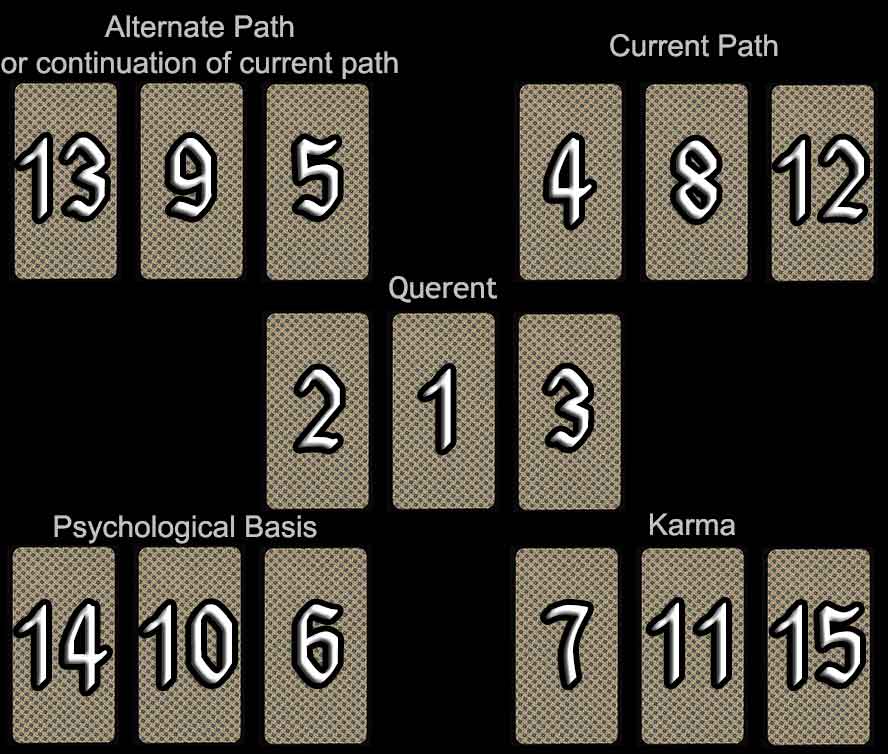
Difficulty: Complicated
Note: Tarot decks that use reversed cards such as the Rider-Waite do not work well with this spread, which was designed to be read using elemental dignity.
The Golden Dawn spread is best suited for use with the bifrost Tarot and especially the Book of Thoth, as these decks are meant to be read a certain way with the court cards. Princes and queens represent actual men and women connected with the matter, while princesses generally represent ideas; thoughts or opinions, and knights represent arrival or departure of a matter depending on the direction faced.
In this tarot spread, particular attention should be paid to a card's exact position in relation to its neighbours. Whether the neighbour cards bear the same energy (suit) determines whether a card is considered well-dignified or ill-dignified. Opposite suits ill-dignify each other, while other suits are considered friendly. Tarot cards of the same suit or element strengthen each other.
As with other tarot spreads, it is important to count the cards' tendencies, such as whether there is a lot of one particular suit or number pattern. The patterns reveal special messages. Having several majors present indicates higher forces at work, several cups suggest strong emotions, etc.
Card #1 represents the reader and the nature of the topic at hand.
Cards #2 & #3 are read in extension of #1 to further comprehend the nature of the topic.
The two sets of three tarot cards at the top of the spread represent chronological sets of events. The current path as it would unfold naturally is represented by cards #4, #8, & #12. The alternate path that could be taken is represented by cards #13, #9, & #5. However, if the reader gets the feeling these cards are telling them they go together, then the alternate path is to be considered an extension of the current path, and to be read chronologically in this order: #4, #8, #12, #13, #9, #5. Just keep in mind: this is only if the two paths seem particularly similar.
Cards #14, #10, & #6 shed light upon the psychological undertones of the current issue.
Cards #7, #11, & #15 represent the influences of karma and destiny beyond the reader's control. These cards suggest adapting to this, as fate.
Your Golden Dawn Reading
| The Alternate Path (or Extension of Current Path) |
Your Current Path |
|||||
VIIII – The Hermit (L'Hermite) |
XXI – The World (Le Monde) |
XI – Strength (La Force) |
II – The Priestess (La Papesse) |
XVIIII – The Sun (Le Soleil) |
XVII – The Star (L'Étoile) |
|
| The Querent | ||||||
III – The Empress (L'Impératrice) |
XVIII – The Moon (La Lune) |
XX – Judgement (Le Jugement) |
||||
| The Psychological Basis | Karma | |||||
XV – The Devil (Le Diable) |
XII – The Hanged Man (Le Pendu) |
XIIII – Temperance |
VII – The Chariot |
X – The Wheel of Fortune (La Roue de Fortune) |
V – The Pope (Le Pape) |
|
The Querent
cards represent the querent and the nature of the topic at hand. The first card (in the center of the spread) represents the very core of the matter, and the other two cards around it are added to it in order to further comprehend the nature of the topic.
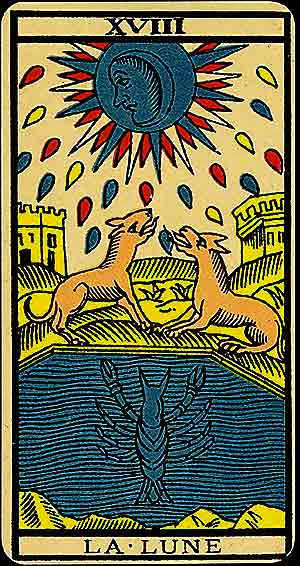
The Moon symbolises intuition, mystery, and the subconscious. It reflects the realm of dreams, illusions, and emotions, inviting you to explore the depths of your psyche and confront hidden truths.
Symbolism: The Moon casts its dim light over a mysterious scene: a dog and a wolf howl beneath its glow, representing the duality of tame and wild instincts. A crayfish emerges from the water, symbolising the hidden depths of the subconscious rising to the surface. The two towers suggest boundaries between reality and the unknown.
In Relationships: Emotional complexity, hidden dynamics, or the need to trust your intuition. Beware of illusions or misunderstandings.
In Work: A period of uncertainty or unclear direction. It encourages careful reflection and trusting inner instincts over external noise.
Spiritually: The Moon calls for introspection and exploration of the shadow self through dreams, intuition, and subconscious symbols.
When ill-dignified: Confusion, deception, or fear of the unknown. It warns against being lost in illusions or succumbing to anxiety.
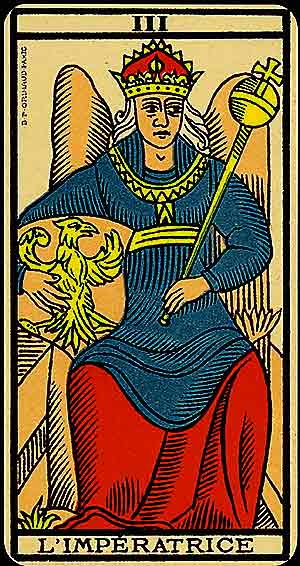
This card signifies the creative force in its most abundant and fertile form. It represents growth, nurturing, and the life-giving power of nature.
Symbolism: Her sceptre symbolises authority rooted in creativity and love, while the shield bearing an eagle emphasises vision and protection. The Empress's seated posture on her throne exudes a sensual yet controlled energy, symbolising the harmony between fertility and structure. Her crown and flowing robes represent her connection to divine beauty and earthly abundance.
In Relationships: The blossoming of love or a nurturing, supportive relationship. It is a call to cultivate affection with care and patience.
In Work: A time of prolific creativity and the manifestation of projects. Trust your ability to bring ideas to fruition.
Spiritually: The Empress guides you to honour your divine creative potential, celebrating the interplay between spirit and matter.
When ill-dignified: Overindulgence, stagnation, or excessive control. It warns against smothering growth or being consumed by material concerns.
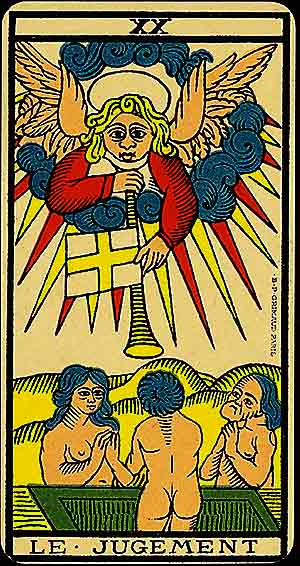
Judgement signifies awakening, transformation, and the call to a higher purpose. It represents a time of reckoning and renewal, offering the opportunity to align with divine will and embrace rebirth.
Symbolism: An angel blows a trumpet from above, awakening figures rising from coffins below. The trumpet symbolises divine calling, while the figures' praying hands reflect surrender and readiness for transformation. The scene suggests liberation and the promise of a new phase of existence.
In Relationships: Healing, forgiveness, or a transformative phase. It may signify a second chance or a fresh start.
In Work: A moment of clarity or a major decision that aligns your work with your higher purpose. Renewal is on the horizon.
Spiritually: Judgement calls you to awaken to your true calling, embrace forgiveness, and prepare for a spiritual rebirth.
When ill-dignified: Resistance to change, self-doubt, or avoidance of accountability. It warns against ignoring the call to transform.
Your Current Path
cards represent your current path as it would unfold naturally. These cards are read in chronological order from left to right.

The High Priestess is the keeper of wisdom and the custodian of sacred knowledge. She represents introspection, patience, and the search for truths hidden beneath the surface.
Symbolism: Seated and serene, the High Priestess holds an open book, symbolising esoteric teachings and mysteries revealed through disciplined study. Her veil represents the boundary between the seen and unseen, while the calm symmetry of her setting reflects inner equilibrium and balance.
In Relationships: Emotional depth and the unfolding of hidden dynamics. This card encourages trust in intuition over appearances.
In Work: A time for reflection and strategy rather than direct action. The answers lie in careful analysis.
Spiritually: The High Priestess invites the seeker to embrace silence and meditation, revealing the wisdom that resides within.
When ill-dignified: Stagnation, secrecy, or confusion. It warns against ignoring inner guidance or withholding necessary truths.
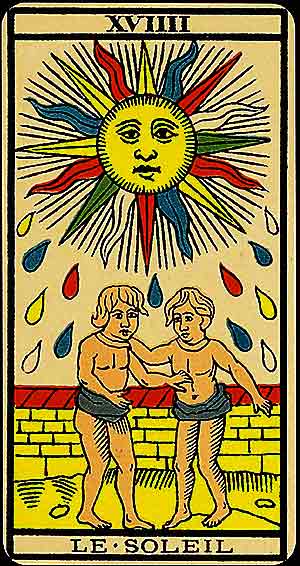
The Sun represents joy, success, and clarity. It is the card of illumination and vitality, promising growth, harmony, and the fulfilment of goals through clarity and connection.
Symbolism: Two children stand joyfully under the radiant Sun, surrounded by a protective wall. The Sun itself symbolises divine energy and enlightenment, while the figures reflect innocence, unity, and shared happiness. The vibrant rays evoke abundance and the thriving life force.
In Relationships: Mutual happiness, harmony, and a joyful connection. Relationships flourish under the light of clarity and love.
In Work: Success and recognition achieved through positivity and effort. It suggests a time of clarity and accomplishment.
Spiritually: The Sun calls for embracing the light within and aligning with your true purpose, radiating joy and love outward.
When ill-dignified: Arrogance, burnout, or overexposure. It warns against taking blessings for granted or letting ego overshadow gratitude.
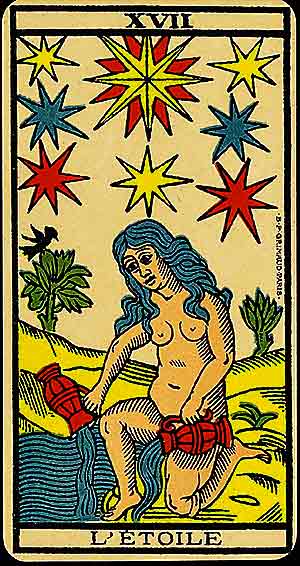
The Star is a card of hope, inspiration, and renewal. It symbolises divine guidance and the gentle flow of healing energy after hardship.
Symbolism: A nude figure kneels beside a stream, pouring water onto the land and back into the source, representing the cyclical nature of renewal and the flow of inspiration. Above her, stars shine brightly, offering hope and illumination.
In Relationships: Healing and harmony. It suggests vulnerability and openness to connection.
In Work: Inspiration and the emergence of new opportunities. A time for trust in your creative vision.
Spiritually: The Star invites you to align with your higher purpose, finding peace in the guidance of the cosmos.
When ill-dignified: Doubt, loss of faith, or feeling disconnected from inspiration. It warns against losing hope during challenging times.
The Alternate Path
cards represent the alternate path that you could choose to take in lieu of the Current Path. However, if the cards that come up seem to indicate that they go along with the Current Path, these three cards should be interpretted not as an Alternate Path, but as a chronological extension of the Current Path (also read from left to right).
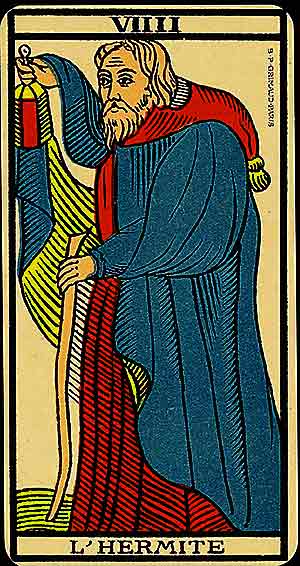
The Hermit represents solitude, introspection, and the pursuit of inner wisdom. He invites the seeker to retreat from distractions and focus on the guiding light within.
Symbolism: An old man walks with a staff, holding a lantern that illuminates his path. The lantern symbolises the light of wisdom gained through introspection and experience. His posture suggests humility and patience, while his cloak emphasises withdrawal from the external world.
In Relationships: A period of self-reflection or a need for solitude to gain clarity on emotional matters.
In Work: A time for careful planning and introspection. Wisdom lies in patient deliberation rather than immediate action.
Spiritually: The Hermit invites the seeker to turn inward, embracing solitude as a space for spiritual awakening and self-discovery.
When ill-dignified: Isolation, fear of introspection, or excessive withdrawal. It warns against cutting oneself off from others or resisting inner truth.

The World is the culmination of the journey, representing fulfilment, harmony, and unity. It signifies the integration of all aspects of life and the successful completion of a cycle, opening the way to new beginnings.
Symbolism: A central figure dances within a laurel wreath, symbolising victory and wholeness. The four corners often depict symbolic creatures (the lion, ox, eagle, and man), representing the elements, the fixed signs of the zodiac, or the four faces of a cherubim. The wreath signifies completion and eternity.
In Relationships: A harmonious, complete relationship or fulfilment of long-term goals in love. It reflects unity and shared purpose.
In Work: The successful culmination of a project or phase. Recognition and achievement mark this time of completion.
Spiritually: Le Monde invites the seeker to embrace the interconnectedness of all things, celebrating unity with the divine and readiness for new journeys.
When ill-dignified: Incompletion, stagnation, or feeling unfulfilled despite external success. It warns against losing sight of the bigger picture or resisting closure.
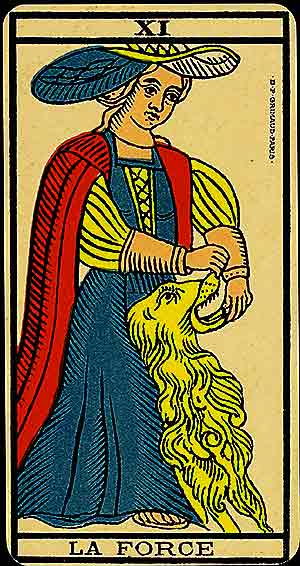
Strength symbolises the mastery of inner strength, courage, and the harmonisation of primal instincts with spiritual awareness. It teaches that true power lies in patience and understanding rather than brute force.
Symbolism: A figure calmly opens the jaws of a lion, symbolising the mental strength required to tame one's baser instincts. The figure's composed expression reflects confidence and inner control. The lion embodies raw energy and passion, while the gentle interaction suggests a balance between wildness and refinement.
In Relationships: Emotional resilience and understanding strengthen relationships. It may indicate a need for patience and compassion in matters of the heart.
In Work: Triumph through determination and calm perseverance. Success comes from maintaining focus and self-discipline.
Spiritually: Strength reflects the integration of instinct and higher consciousness, inviting you to connect with your inner power.
When ill-dignified: Impulsiveness, weakness, or unchecked aggression. It warns against letting fear or uncontrolled passions take the lead.
The Psychological Basis
cards shed light upon the psychological undertones of the current problem.
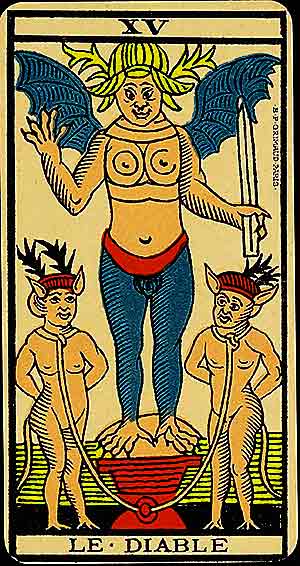
The Devil represents temptation, materialism, and the power of the shadow self. While it warns of unhealthy attachments, it also offers an opportunity to confront and integrate the darker aspects of human nature.
Symbolism: A horned figure dominates the scene, with two smaller chained figures below, symbolising bondage to desires or fears. The loose chains suggest that this bondage is self-imposed and can be escaped. The card's imagery reflects both the allure and consequences of indulgence.
In Relationships: Obsessive or co-dependent relationships. It may indicate intense passion or unhealthy dynamics.
In Work: Temptation to take shortcuts or pursue goals at the expense of ethics. A need to reassess priorities.
Spiritually: The Devil challenges you to confront your shadow self and transform fears into liberation.
When ill-dignified: Escapism, addiction, or manipulative behaviours. It warns of being trapped in destructive patterns.
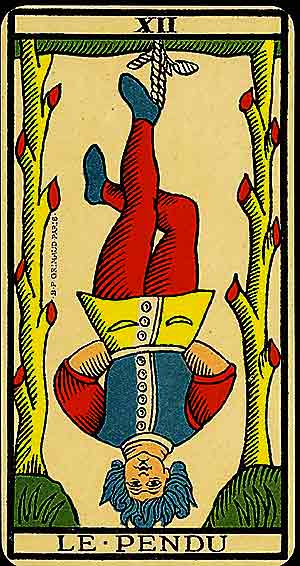
The Hanged Man represents surrender, perspective, and the wisdom gained through sacrifice. It signifies the pause required for deeper insight and the willingness to let go of attachments to achieve spiritual growth.
Symbolism: A figure hangs upside down from a grafted tree, forming an almost serene cross-like posture. The inversion suggests seeing the world from a different perspective, while the living tree structure reflects the connection to spiritual growth. His tranquil expression emphasises acceptance and enlightenment through suspension.
In Relationships: A need for patience, reflection, or a fresh perspective on a relationship. It can also suggest letting go of control.
In Work: A time to pause, reassess, and allow things to unfold. Solutions may come from viewing challenges differently.
Spiritually: The Hanged Man invites the seeker to embrace surrender as a path to awakening and profound understanding.
When ill-dignified: Stubbornness, resistance to change, or avoiding necessary sacrifices. It warns against remaining stuck in unproductive situations.
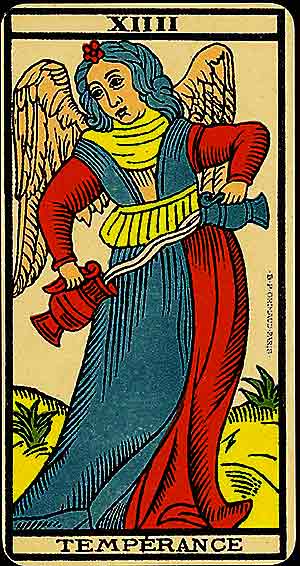
Temperance embodies balance, harmony, and the art of blending opposites into a unified whole. It is a card of moderation and integration, calling for patience and the gentle flow of energies.
Symbolism: An angelic figure pours water between two vessels, symbolising the interplay of opposites and the alchemical transformation process. One cup is blue, and the other is red, suggesting a balance between the material and the spiritual.
In Relationships: Harmony and mutual understanding within relationships. It suggests compromise and blending energies for a greater whole.
In Work: A need for patience and adaptability. Success comes through steady effort and the balancing of resources.
Spiritually: Temperance invites you to harmonise opposing aspects of your being and align with the universal flow.
When ill-dignified: Imbalance, impatience, or excess. It warns against pushing too hard or failing to find equilibrium.
Karma
These cards represent the influences of karma and destiny that are beyond your control. They suggest adapting to this fate.
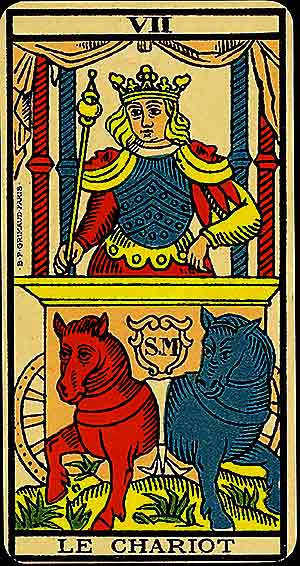
The Chariot represents triumph through willpower and discipline. It is the card of focused determination, suggesting the mastery of opposing forces to achieve a unified goal.
Symbolism: The charioteer stands tall, guiding two horses of contrasting colours, symbolising duality and control. The canopy above him evokes divine protection, while the wheels in motion reflect progress and momentum. His expression is resolute, embodying control amidst dynamic movement.
In Relationships: Moving forward together, overcoming challenges, or achieving harmony despite differences.
In Work: Success through focus, persistence, and strategic action. Victory is attainable through balance and self-control.
Spiritually: The Chariot teaches the alignment of inner and outer forces, calling for the integration of spirit and will to advance.
When ill-dignified: Lack of direction, recklessness, or internal conflict. It warns against being pulled in opposing directions without clarity of purpose.
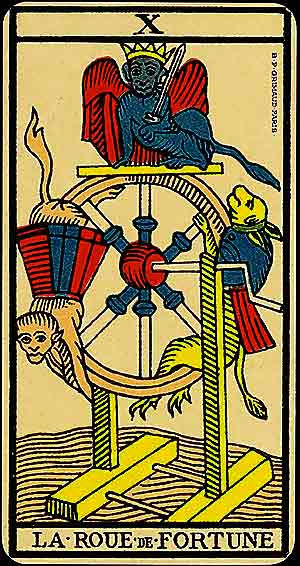
The Wheel of Fortune symbolises the ever-turning cycles of life, fate, and destiny. It teaches the importance of adaptability and trust in the rhythms of change.
Symbolism: The wheel is adorned with figures ascending and descending, representing the rise and fall of fortunes. Its circular motion evokes the cyclical nature of existence, while divine forces implied by the card's design suggest that some aspects of life are beyond human control.
In Relationships: Changes in relationship dynamics or the appearance of new opportunities. Trust in the flow of events.
In Work: A shift in circumstances, often bringing unexpected opportunities. Stay flexible and open to change.
Spiritually: The Wheel of Fortune reflects the interconnectedness of life's cycles, encouraging surrender to the divine plan.
When ill-dignified: Resistance to change or clinging to outdated patterns. It warns of losing perspective during times of transition.
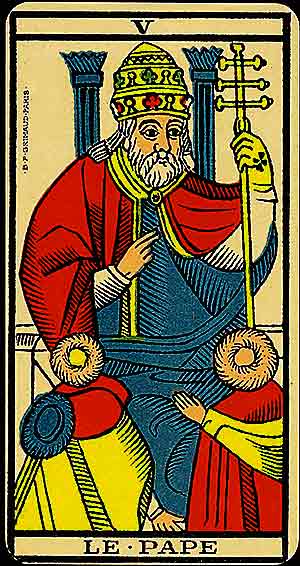
The Hierophant bridges the earthly and the divine, symbolising tradition, spiritual guidance, and the transmission of sacred knowledge. He represents the connection between the seeker and a higher truth through structure and ritual.
Symbolism: The Hierophant sits between two pillars, a gesture of blessing extended towards two kneeling figures below him. His triple cross sceptre represents spiritual authority, while the two fingers pointing to his heart suggest access to divine mysteries. His serene expression reflects wisdom tempered with compassion.
In Relationships: A relationship built on shared values. It can also signify guidance or mentorship within a partnership.
In Work: Success through adherence to structure, tradition, or established methods. Seek advice from a mentor or institution.
Spiritually: The Hierophant invites the seeker to explore established spiritual paths, finding wisdom in teachings passed down through generations.
When ill-dignified: Dogmatism, resistance to change, or blind adherence to tradition. It warns against sacrificing individuality for conformity.